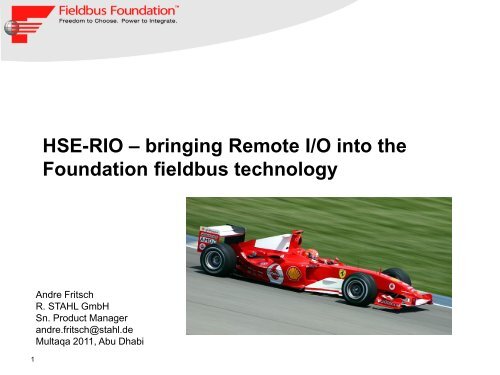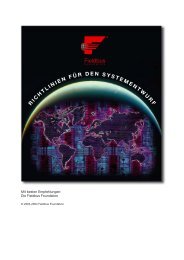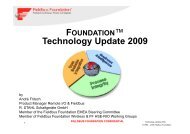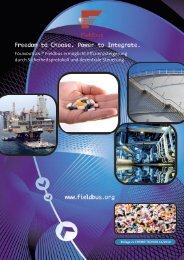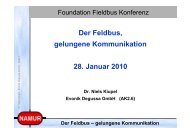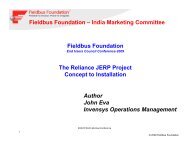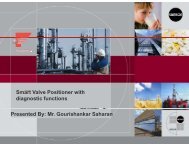HSE-RIO - Fieldbus Foundation
HSE-RIO - Fieldbus Foundation
HSE-RIO - Fieldbus Foundation
Create successful ePaper yourself
Turn your PDF publications into a flip-book with our unique Google optimized e-Paper software.
1<br />
<strong>HSE</strong>-<strong>RIO</strong> – bringing Remote I/O into the<br />
<strong>Foundation</strong> fieldbus technology<br />
Andre Fritsch<br />
R. STAHL GmbH<br />
Sn. Product Manager<br />
andre.fritsch@stahl.de<br />
Multaqa 2011, Abu Dhabi
2<br />
<strong>HSE</strong> - the new kid on the block ?<br />
2003…2008
3<br />
H1 and <strong>HSE</strong> - Scalable Environment<br />
One Technology At Two Speeds<br />
H1 host<br />
FIELDBUS H1<br />
FF <strong>HSE</strong><br />
Linking Device<br />
<strong>HSE</strong>/H1<br />
FIELDBUS H1
4<br />
as of November 2011
5<br />
Wireless and Remote I/O- the new kids on the block !!!<br />
WIO = Wireless & remote IO<br />
2011
6<br />
How it started…<br />
3<br />
ISA EXPO 2006 Press Conference<br />
Latest News:<br />
Initiative Bringing Remote I/O To FOUNDATION<br />
Technology (Cont’d)<br />
� Worldwide end user demand for a single<br />
network infrastructure drives our specification<br />
development effort<br />
� Specification will define structure for interfacing<br />
remote I/O over tightly integrated High Speed<br />
Ethernet (<strong>HSE</strong>) control backbone<br />
� Addition of remote I/O will further tighten<br />
integration of process instrumentation within the<br />
FOUNDATION architecture<br />
ISA EXPO 2006 Press Conference<br />
Houston, TX<br />
© 1999 – 2006 <strong>Fieldbus</strong> <strong>Foundation</strong>
7<br />
…and how it is today!<br />
EUAC Advisor<br />
Herman Storey<br />
Herman Storey Consulting<br />
WIO<br />
Program Manager<br />
Jon Malins<br />
Cooper- MTL<br />
<strong>HSE</strong> <strong>RIO</strong><br />
Technical Team Leader<br />
Detlef Arndt<br />
P+F<br />
<strong>HSE</strong> <strong>RIO</strong><br />
Development Team<br />
TSC Liaison<br />
Libanio de Souza<br />
Smar<br />
WIO Program Director<br />
ISA100.15 Backhaul/Backbone Co-Chair<br />
FIC <strong>HSE</strong> Wireless Backhaul Program Manager<br />
WCT Project Coordinator<br />
TSC Chairman<br />
Dave Glanzer<br />
<strong>Fieldbus</strong> <strong>Foundation</strong><br />
WIO Chief Architect<br />
Naoyuki Fukao<br />
Yamatake<br />
ISA100.15 Backhaul/Backbone Co-Chair<br />
FIC Technical Team Leader<br />
Penny Chen<br />
Yokogawa<br />
FIC <strong>HSE</strong> Backhaul<br />
Development Team<br />
WCT Liaison<br />
WCT Technical Team Leader<br />
Marcos Peluso<br />
Emerson<br />
Wireless Sensor Interface Team<br />
Program Manager &<br />
Technical Team Leader<br />
Pat Brett<br />
Honeywell<br />
WSIT<br />
Development Team<br />
WIO Fast Track Marketing Demo<br />
Larry O’Brian<br />
Talon Petty<br />
<strong>Fieldbus</strong> <strong>Foundation</strong><br />
Device Registration<br />
Process<br />
Darie Dreptate<br />
Stephen Mitschke<br />
<strong>Fieldbus</strong> <strong>Foundation</strong><br />
WIO<br />
Validation Team Leader<br />
Johannes Lang<br />
R. STAHL<br />
WIO<br />
Validation Team
Conventio<br />
nal<br />
I/O<br />
8<br />
WIO Development Teams<br />
<strong>HSE</strong> <strong>RIO</strong> Team<br />
H1<br />
Wired<br />
HART<br />
Host<br />
Gateway<br />
<strong>Fieldbus</strong> <strong>Foundation</strong> - ISA100<br />
Cooperation<br />
WirelessHART<br />
<strong>HSE</strong> Backhaul Team<br />
ISA100.11a<br />
Wireless Sensor Team
9<br />
WIO Development Phases<br />
WIO Phase 1<br />
<strong>HSE</strong> Remote I/O<br />
Wired<br />
FF <strong>HSE</strong><br />
Convent’l<br />
I/O<br />
Gateway<br />
HART I/O<br />
FF H1<br />
WIO Phase 2<br />
<strong>HSE</strong> Backhaul<br />
&<br />
WirelessHART I/F<br />
Wired<br />
FF <strong>HSE</strong><br />
or<br />
Gateway<br />
Wireless<br />
HART<br />
Wireless<br />
FF <strong>HSE</strong><br />
backhaul<br />
WIO Phase 3<br />
Flexible Function Blocks<br />
&<br />
I/F to other Networks<br />
Wired<br />
FF <strong>HSE</strong><br />
Convent’l<br />
I/O<br />
Gateway<br />
HART I/O<br />
or<br />
Wireless<br />
FF <strong>HSE</strong><br />
Backhaul<br />
FFB<br />
Other<br />
networks<br />
WIO Phase 4<br />
Wired<br />
FF <strong>HSE</strong><br />
ISA100 I/F<br />
or<br />
Gateway<br />
ISA100.11a<br />
Wireless<br />
FF <strong>HSE</strong><br />
Backhaul
10<br />
H1 and <strong>HSE</strong>- Scalable Environment<br />
One Technology At Two Speeds<br />
Control System<br />
Host<br />
FIELDBUS H1<br />
May be Combined<br />
Asset<br />
Managing<br />
Host<br />
FF <strong>HSE</strong><br />
WIO<br />
Conventional<br />
I/O<br />
HART AI<br />
FF <strong>HSE</strong>-<strong>RIO</strong><br />
& Wireless<br />
Wireless I/O<br />
HART<br />
AO
11<br />
From <strong>HSE</strong>-<strong>RIO</strong> to WIO to ROM
12<br />
More than just <strong>RIO</strong>…<br />
� 2.1 Gateways to other buses<br />
� 2.2 Remote Logic<br />
� 2.3 Simple I/O<br />
� 2.4 Hot Swappable I/O Cards - Transparent to Fault Tolerance<br />
� 2.5 Change field device parameter while operating<br />
� 2.6 Acyclic communication to access config, diagnostic & maintenance data<br />
� 2.7 Device Power<br />
� 2.8 Hazardous Location Installation<br />
� 2.9 Offline Configuration<br />
� 2.10 Motor Control Center Comms<br />
� 2.11 Variable Speed Drives<br />
� 2.12 Sequence of Events (High Resolution Timing)<br />
� 2.13 Redundant I/O Cards - Transparent to Fault Tolerance<br />
� 2.14 Configuration changes while in service<br />
� 2.15 Change control strategy while in service<br />
� 2.16 <strong>HSE</strong>-<strong>RIO</strong> used as an RTU<br />
� 2.17 Data buffer with Burst communications (Loss of comm without losing history)<br />
� 2.18 Process Interrupt driven control execution<br />
� 2.19 Distinguish & prioritize between Control & Device Support and Config Comms<br />
� 2.20 <strong>HSE</strong> Interoperability<br />
� 2.21 Standard Connection Mechanism (Physical Layer - Cables, Connectors etc.)<br />
� 2.22 Redundant Comm<br />
� 2.23 Fault Tolerant Comm<br />
� 2.24 Functional Safety - Support of FOUNDATION SIF<br />
� 2.25 Historic data retrieval<br />
� 2.26 Device status of self comms, physical layer & connected devices<br />
� 2.27 <strong>RIO</strong> Pass through (routable) system (i.e. VPN, Internet, Tunneling)<br />
� 2.28 Security<br />
� 2.29 Configuration change status in <strong>HSE</strong>-<strong>RIO</strong> reported<br />
� 2.30 High Frequency Update<br />
� 2.31 <strong>HSE</strong>-<strong>RIO</strong> capacities<br />
from <strong>HSE</strong>-<strong>RIO</strong> Use Case document
13<br />
Emission<br />
Monitor<br />
More potential FF <strong>HSE</strong> Applications<br />
Gas<br />
Analyzer<br />
Variable<br />
Gas Speed Drive<br />
Chromatograph<br />
Coriolis Mass<br />
Flow Meter<br />
Linking<br />
Device<br />
Ultrasonic<br />
Flow Meter<br />
Machinery<br />
Vibration<br />
Monitoring<br />
<strong>RIO</strong> &<br />
RTU<br />
Flow<br />
Computer<br />
Wireless<br />
Gateway
14<br />
So why do we need something new?<br />
To integrate a modular system for large data quantities into „classic“<br />
<strong>Foundation</strong> architecture, some add-ons were required.<br />
From „FF-061 System Architecture for WIO“:<br />
� 1. Introduction<br />
<strong>HSE</strong> Remote Input/Output devices and Wireless Gateways/RTUs are<br />
examples of high point-count <strong>HSE</strong> devices that are aggregates of<br />
various components that will vary from one user instance to another<br />
user instance. The traditional small H1 device model and small<br />
pointcount <strong>HSE</strong> device model may not be a sufficient model for such<br />
a device. With device size permitted to vary from a few dozen points<br />
to several thousand points, scalability of the architecture is a<br />
requirement.
15<br />
And what‘s new now?<br />
� Association Block<br />
� special form of transducer block<br />
� also required for offline configuration<br />
� description of hirarchical and functional organization of modules (e.g.<br />
slot and functionality of installed IO-module)<br />
� association of head module (gateway) with possible set of IO-modules<br />
� association of module (I/O or gateway) with it‘s individual transducer<br />
blocks
16<br />
And what‘s new now?<br />
� Element redundancy<br />
� optional (depends on supplier)<br />
� not limited – dual, triple etc.<br />
� all kinds of redundancy supported (head module, IO-module, cable)<br />
� internal handling (e.g. configuration of modules) by head module
17<br />
And what‘s new now?<br />
� Transducer block for <strong>HSE</strong>-<strong>RIO</strong><br />
� one <strong>HSE</strong>-<strong>RIO</strong> TB for each <strong>HSE</strong>-<strong>RIO</strong> module (slot)<br />
� handles data transfer between physical IO and function block<br />
application<br />
� redundancy handled by association block<br />
� link between transducer and function block via channel tags<br />
TB TB TB
18<br />
And what‘s new now?<br />
� Function block for <strong>HSE</strong>-<strong>RIO</strong> (FF-633 part 6)<br />
� minimize CPU power for processing large number of IO-points<br />
� minimize amount of data for configuration of IO-blocks<br />
� minimize number of links between <strong>RIO</strong> and control device (!!)<br />
� 4 additional new function blocks with limited features compared to<br />
single function blocks (e.g. only block alarm):<br />
� MBI-64, MBO-64, MAI-16, MAO-16<br />
� single function blocks to be used to access full features
For FF experts only…<br />
Single FB<br />
AI<br />
Multi FB<br />
MAI<br />
WIO FB<br />
MAI-16<br />
No. of Input 1<br />
No. of Input 8<br />
No. of Input<br />
16<br />
View View View View<br />
View 1 View 3 View 3 View 4 View 1 View 3 View 3 View 4<br />
1 3 3 4<br />
1 ST_REV 2 2 2 2 ST_REV 2 2 2 2 ST_REV 2 2 2 2<br />
2 TAG_DESC TAG_DESC TAG_DESC<br />
3 STRATEGY 2 STRATEGY 2 STRATEGY 2<br />
4 ALART_KEY 1 ALERT_KEY 1 ALERT_KEY 1<br />
5 MODE_BLK 4 4 MODE_BLK 4 4 MODE_BLK 4 4<br />
6 BLOCK_ERR 2 2 BLOCK_ERR 2 2 BLOCK_ERR 2 2<br />
7 PV 5 5 CHANNEL 2 FORCE_ENB_16 2 2<br />
8 OUT 5 5 OUT_1 5 5 CHANNEL_TAG_16<br />
9 SIMULATE OUT_2 5 5 OUTM_16 84 84<br />
10 XD_SCALE 11 OUT_3 5 5 MAP_MM_16 2 2<br />
11 OUT_SCALE 11 OUT_4 5 5 UPDATE_EVT<br />
12 GRANT_DENY 2 OUT_5 5 5 BLOCK_ALM<br />
13 IO_OPTS 2 OUT_6 5 5<br />
14 STATUS_OPTS 2 OUT_7 5 5<br />
15 CHANNEL 2 OUT_8 5 5<br />
16 L_TYPE 1 UPDATE_EVT<br />
17 LOW_CUT 4 BLOCK_ALM<br />
18 PV_FTIME 4<br />
19<br />
20<br />
FIELD_VAL<br />
UPDATE_EVT<br />
5 5<br />
MAI function block<br />
21 BLOCK_ALM<br />
22 ALARM_SUM 8 8<br />
23 ACK_OPTION 2<br />
24 ALARM_HYS 4<br />
25 HI_HI_PRI 1<br />
26 HI_HI_LIM 4<br />
27 HI_PRI 1<br />
28 HI_LIM 4<br />
29 LO_PRI 1<br />
30<br />
31<br />
LO_LIM<br />
LO_ LO_PRI<br />
4<br />
1 AI function block<br />
32 LO_ LO_LIM 4<br />
33 HI_HI_ALM<br />
34 HI_ALM<br />
35<br />
36<br />
LO_ALM<br />
19<br />
LO_ LO_ALM<br />
NEW: MAI-16 <strong>RIO</strong> function block
20<br />
And what‘s new now?<br />
� Control in the field <strong>RIO</strong><br />
� an <strong>HSE</strong>-<strong>RIO</strong> is based on function blocks like any H1 fieldbus device<br />
� each IO-module has it‘s own function & transducer blocks<br />
� therefor a link between function blocks inside a <strong>RIO</strong> system is possible<br />
as well
21<br />
And what‘s new now?<br />
� Transducer block for wired & wireless HART<br />
� represents HART devices within <strong>HSE</strong>-<strong>RIO</strong> devices.<br />
� Wired HART and WirelessHART devices may be represented in this<br />
block.<br />
� Describes the expected method for HART configuration tools and<br />
asset-managing hosts to access HART devices using the native HART<br />
command protocol transported through the <strong>Foundation</strong> High Speed<br />
Ethernet (<strong>HSE</strong>) network.<br />
� The specification also defines structures to identify and maintain<br />
HART device status in wired multi-drop networks as well as in<br />
WirelessHART mesh networks<br />
� Alternative solution : mapping of HART variables into the standard AI<br />
transducer blocks -> standard HART devices become multi variable<br />
device.
22<br />
Overview <strong>HSE</strong>-<strong>RIO</strong> concept<br />
from FF-633 Part 6
23<br />
Does it work?<br />
Media Event – 1 st of Dec. 2011
24<br />
Example <strong>HSE</strong>-<strong>RIO</strong> configuration
25<br />
Ethernet & <strong>HSE</strong> – the perfect team<br />
Additional diagnostics via Webserver
26<br />
Explosion protection for FF <strong>HSE</strong>?<br />
see Multaqa<br />
2009<br />
Control System<br />
Host<br />
FIELDBUS H1<br />
May be Combined<br />
Asset<br />
Managing<br />
Host<br />
FF <strong>HSE</strong><br />
Remote<br />
IO<br />
Convention<br />
al I/O<br />
HART AI<br />
HART<br />
AO<br />
Ex ?
27<br />
The next steps…<br />
� <strong>Foundation</strong> has started F-ROM:<br />
<strong>Foundation</strong> for Remote Operations<br />
Management<br />
� First media event 1st December 2011 in USA<br />
� Small end user demos Q1…Q3 2012<br />
� Big Demo event at end user sites Q3-2012<br />
� Ask your DCS supplier for support of this<br />
new <strong>HSE</strong>-<strong>RIO</strong> functionality!


